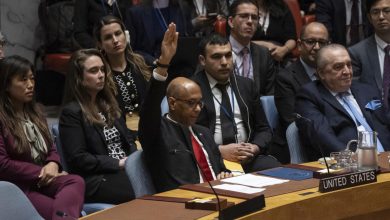In American cities, black and Latino neighborhoods have less access to pharmacies


MONTGOMERY, Ala. (AP) — Parts of Montgomery’s north side are defined by what they lost: restaurants, grocery stores and a convenient pharmacy, the latter of which closed five years ago.
People who still live in the historically black Newtown neighborhood, like Sharon Harris, are frustrated. She goes to another location of the same pharmacy chain, located six kilometers from her home.
“Sometimes you have to come back,” she said, “and then they wait so long to fill the prescription.” »
In cities across the United States, large retail pharmacies have closed hundreds of stores in recent years, and independents can’t always afford to stay open. This can leave residents of color without easy access to a company that provides not only prescriptions, but also basic public health services like vaccinations, over-the-counter medications, and even food.
The closures create “a situation where there is not only (a lack of) investment in terms of pharmacy development and expansion, but there is no incentive to stay in these neighborhoods,” said Dima Qato, professor of clinical pharmacy at the University of Southern California. studied access to pharmacies.
And an Associated Press analysis of licensing data from 44 states, data from the National Council for Prescription Drug Programs and the American Community Survey shows that residents of majority black and Hispanic neighborhoods have fewer pharmacies per year. resident than people living in predominantly white neighborhoods.
MAC Pharmacy is the only one serving about 20,000 people in a predominantly black zip code in Cleveland. George Tadross, co-owner and manager of the pharmacy, said he was keen to make things as easy as possible for his mostly older customers, sometimes by arranging their medications by day for them.
“You have to have a pharmacist to talk to,” he says. “My philosophy in pharmacy is that you know your doctor, he knows everything about you. You also need to know your pharmacist (because) the pharmacist is the only one who sees your entire medical treatment plan.
Pharmacists play a role in managing chronic conditions like diabetes and heart problems, which Black and Hispanic people are more likely to be diagnosed with.
And when pharmacists or pharmacy technicians reflect their customer base — speaking the same language or understanding the community — it can be easier to build a strong relationship and trust, said Jasmine Gonzalvo, who teaches in the College of Pharmacy from Purdue University and studied the needs. of Spanish-speaking patients in pharmacies.
She noted that if people don’t feel comfortable asking questions about the medication, it may mean they aren’t taking it or aren’t taking it correctly.
“You’re not getting a refill,” Gonzalvo said, “simply because there were barriers to your communication and your sense of security in that relationship with your pharmacist.”
That’s why Bert’s Pharmacy in Elizabeth, New Jersey, has “staff speaking Spanish and English all the time,” said owner and pharmacist Prakash Patel. His business is located in a ZIP code where nearly 70 percent of residents are Hispanic.
“We also want to make sure they understand everything,” Patel said. “We have labels in Spanish for them, we print all the instructions for them in Spanish. »
In Montgomery, where Harris lives, the city is working on a development plan for the North Side. A detailed analysis of the plan shows that a small pharmacy could generate $1.5 million in sales per year.
“There is an opportunity there because you have what I call a captive market,” said Bob Gibbs, principal at Gibbs Planning Group, which conducted the analysis. “The people who live in many of these neighborhoods have limited access to transportation…and they are very loyal to local businesses who treat them with respect.
“They will do everything they can just to get there. And they just don’t like having to drive… three miles to get to a pharmacy. It is unfair.”
Harris, however, doesn’t have much hope that a new pharmacy will open.
“I don’t see it,” she said. “As long as they have (this CVS), they think it’s OK. … Everyone is waiting for them to do something on this side.
___
Associated Press data journalist Kasturi Pananjady in Philadelphia and video journalist Shelby Lum in New York contributed to this report.
___
The Associated Press Health and Science Department receives support from the Howard Hughes Medical Institute’s Science and Education Media Group and the Robert Wood Johnson Foundation. The AP is solely responsible for all content.
yahoo





